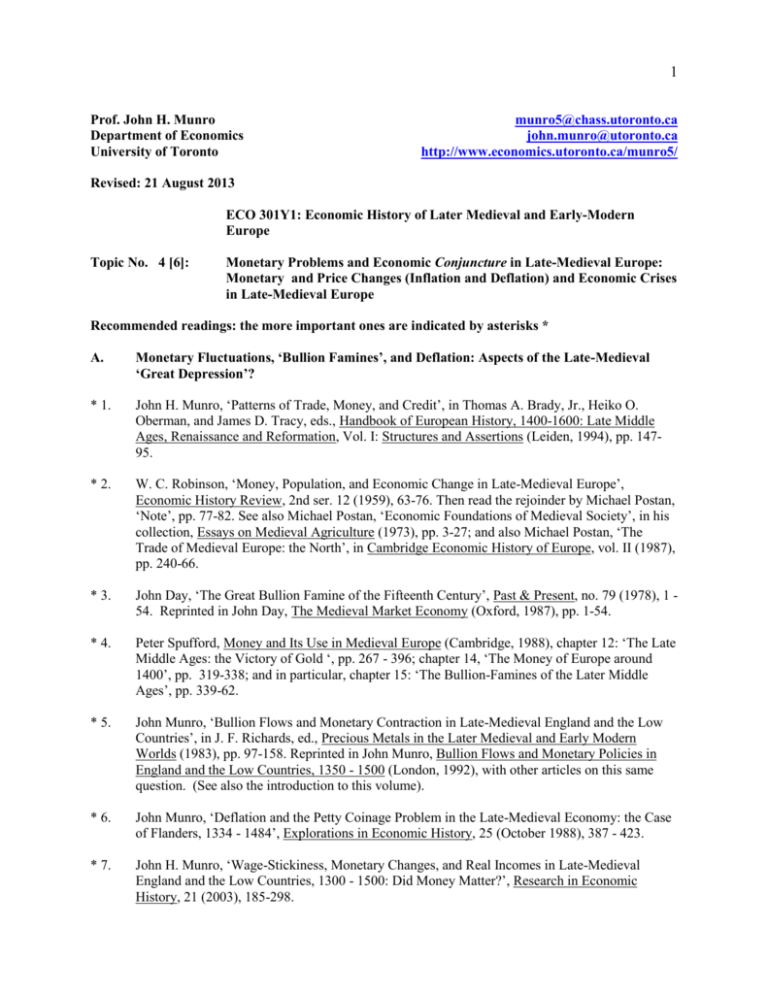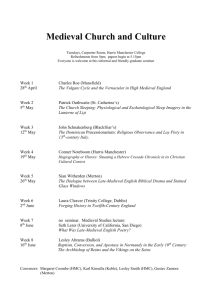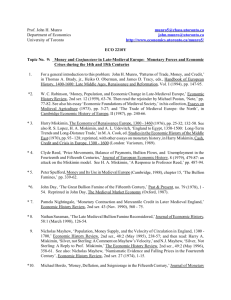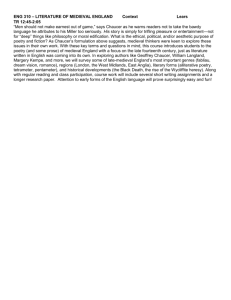MS Word - Department of Economics
advertisement

1 Prof. John H. Munro Department of Economics University of Toronto munro5@chass.utoronto.ca john.munro@utoronto.ca http://www.economics.utoronto.ca/munro5/ Revised: 21 August 2013 ECO 301Y1: Economic History of Later Medieval and Early-Modern Europe Topic No. 4 [6]: Monetary Problems and Economic Conjuncture in Late-Medieval Europe: Monetary and Price Changes (Inflation and Deflation) and Economic Crises in Late-Medieval Europe Recommended readings: the more important ones are indicated by asterisks * A. Monetary Fluctuations, ‘Bullion Famines’, and Deflation: Aspects of the Late-Medieval ‘Great Depression’? * 1. John H. Munro, ‘Patterns of Trade, Money, and Credit’, in Thomas A. Brady, Jr., Heiko O. Oberman, and James D. Tracy, eds., Handbook of European History, 1400-1600: Late Middle Ages, Renaissance and Reformation, Vol. I: Structures and Assertions (Leiden, 1994), pp. 14795. * 2. W. C. Robinson, ‘Money, Population, and Economic Change in Late-Medieval Europe’, Economic History Review, 2nd ser. 12 (1959), 63-76. Then read the rejoinder by Michael Postan, ‘Note’, pp. 77-82. See also Michael Postan, ‘Economic Foundations of Medieval Society’, in his collection, Essays on Medieval Agriculture (1973), pp. 3-27; and also Michael Postan, ‘The Trade of Medieval Europe: the North’, in Cambridge Economic History of Europe, vol. II (1987), pp. 240-66. * 3. John Day, ‘The Great Bullion Famine of the Fifteenth Century’, Past & Present, no. 79 (1978), 1 54. Reprinted in John Day, The Medieval Market Economy (Oxford, 1987), pp. 1-54. * 4. Peter Spufford, Money and Its Use in Medieval Europe (Cambridge, 1988), chapter 12: ‘The Late Middle Ages: the Victory of Gold ‘, pp. 267 - 396; chapter 14, ‘The Money of Europe around 1400’, pp. 319-338; and in particular, chapter 15: ‘The Bullion-Famines of the Later Middle Ages’, pp. 339-62. * 5. John Munro, ‘Bullion Flows and Monetary Contraction in Late-Medieval England and the Low Countries’, in J. F. Richards, ed., Precious Metals in the Later Medieval and Early Modern Worlds (1983), pp. 97-158. Reprinted in John Munro, Bullion Flows and Monetary Policies in England and the Low Countries, 1350 - 1500 (London, 1992), with other articles on this same question. (See also the introduction to this volume). * 6. John Munro, ‘Deflation and the Petty Coinage Problem in the Late-Medieval Economy: the Case of Flanders, 1334 - 1484’, Explorations in Economic History, 25 (October 1988), 387 - 423. * 7. John H. Munro, ‘Wage-Stickiness, Monetary Changes, and Real Incomes in Late-Medieval England and the Low Countries, 1300 - 1500: Did Money Matter?’, Research in Economic History, 21 (2003), 185-298. 2 * 8. John Munro, ‘Before and After the Black Death: Money, Prices, and Wages in FourteenthCentury England’, in Troels Dahlerup and Per Ingesman, eds., New Approaches to the History of Late Medieval and Early Modern Europe: Selected Proceedings of Two International Conferences at The Royal Danish Academy of Sciences and Letters in Copenhagen in 1997 and 1999, Historisk-filosofiske Meddelelser, no. 104 (Copenhagen: The Royal Danish Academy of Sciences and Letters, 2009), pp. 335-364. * 9. John Munro, ‘The Late-Medieval Decline of English Demesne Agriculture: Demographic, Monetary, and Political-Fiscal Factors’, in Mark Bailey and Stephen Rigby, eds., Town and Countryside in the Age of the Black Death: Essays in Honour of John Hatcher, The Medieval Countryside, vol. 12 (Turnhout: Brepols, 2012), pp. 299-348. *10 . John Munro, ‘The Monetary Origins of the ‘Price Revolution’: South German Silver Mining, Merchant-Banking, and Venetian Commerce, 1470-1540’, in Dennis Flynn, Arturo Giráldez, and Richard von Glahn, eds., Global Connections and Monetary History, 1470 - 1800 (Aldershot and Brookfield, Vt: Ashgate Publishing, 2003), pp. 1-34. [For next term’s topic on the ‘Price Revolution’. *11. Pamela Nightingale, ‘Monetary Contraction and Mercantile Credit in Later Medieval England’, Economic History Review, 2nd ser. 43 (Nov. 1990), 560 - 75. *12. Pamela Nightingale, ‘Gold, Credit, and Mortality: Distinguishing Deflationary Pressures on the Late Medieval English Economy’, Economic History Review, 63:4 (November 2010), 10811104. *13. Michael Bordo, ‘Money, Deflation, and Seigniorage in the Fifteenth Century’, Journal of Monetary Economics, 18 (1986), 337-46. Discusses the Miskimin thesis. Evidently missing from the library *14. Nathan Sussman, ‘The Late Medieval Bullion Famine Reconsidered’, Journal of Economic History, 58:1 (March 1998), 126-54. *15. Nicholas Mayhew, ‘Population, Money Supply, and the Velocity of Circulation in England, 1300 - 1700’, Economic History Review, 2nd ser., 48:2 (May 1995), 238-57; and then read: Harry A. Miskimin, ‘Silver, not Sterling: A Comment on Mayhew’s Velocity’, and N.J. Mayhew, ‘Silver, Not Sterling: A Reply to Prof. Miskimin’, The Economic History Review, 2nd ser., 49:2 (May 1996), 358-61. See also: Nicholas Mayhew, ‘Numismatic Evidence and Falling Prices in the Fourteenth Century’, Economic History Review, 2nd ser. 27 (1974), 1-15. *16. Harry Miskimin, The Economy of Renaissance Europe, 1300 - 1460 (1976), pp. 25-32; 132-50. See also R. S. Lopez, H. A. Miskimin, and A. L. Udovitch, ‘England to Egypt, 1350-1500: LongTerm Trends and Long-Distance Trade’, in M. A. Cook, ed., Studies in the Economic History of the Middle East (1970), pp. 93 - 128; reprinted, with other essays on monetary history, in Harry Miskimin, Cash, Credit and Crisis in Europe, 1300 - 1600 (London: Variorum, 1989). *17. Clyde Reed, ‘Price Movements, Balance of Payments, Bullion Flows, and Unemployment in the Fourteenth and Fifteenth Centuries’, Journal of European Economic History, 8 (1979), 479-87: an attack on the Miskimin model. In this same issue, see also H. A. Miskimin, ‘A Response to Professor Reed’, pp. 487-94. 3 *18. Diana Wood, ed., Medieval Money Matters (Oxford: Oxbow Books, 2004): a) James L. Bolton, ‘What is Money? What is a Money Economy? When Did a Money Economy Emerge in Medieval England?’, pp. 1-15. b) Richard Britnell, ‘Use of Money in Medieval England’, pp. 16-30. c) Martin Allen, ‘The English Currency and the Commercialization of England Before the Black Death’, pp. 31-50. d) Pamela Nightingale, ‘Money and Credit in the Economy of Late Medieval England’, pp. 51-71. e) Nicholas H. Mayhew, ‘Coinage and Money in England, 1086 - 1500’, pp. 7286. * 19. James Bolton, Money in the Medieval English Economy, 978 - 1489 (Manchester and New York: Manchester University Press, 2012). Disputes the current late-medieval ‘bullion famine’ theses – denying that there was a problem of monetary contraction. See my online review for EH.Net (17 June 2013): http://eh.net/book_reviews/money-medieval-english-economy-973-1489 B. Coinage Debasements: Causes and Consequences for the late-medieval European economy * 1. C.M. Cipolla, ‘Currency Depreciation in Medieval Europe’, Economic History Review, 2nd ser. 15 (1963), 413-33. * 2. Peter Spufford, Money and Its Use in Medieval Europe (Cambridge, 1988), Chapter 13, ‘The Scourge of Debasement’, pp. 289-318. 3. Nathan Sussman, ‘Debasements, Royal Revenues, and Inflation in France during the Hundred Years' War, 1415 - 1422’, The Journal of Economic History, 53 (March 1993), 44 - 70. * 4. Nathan Sussman and Joseph Zeira, ‘Commodity Money Inflation: Theory and Evidence from France in 1350-1430’, Journal of Monetary Economics, 50:8 (November 2003), 1769-1793. * 5. John Munro, Wool, Cloth, and Gold: The Struggle for Bullion in Anglo-Burgundian Trade, 1340-1478 (Brussels and Toronto, 1973), especially chapter 1: ‘Late Medieval Monetary Policies and the Economics of Bullionism’. 6. John Munro, ‘Deflation and the Petty Coinage Problem in the Late-Medieval Economy: the Case of Flanders, 1334 - 1484’, Explorations in Economic History, 25 (October 1988), 387 - 423. 7. John Munro, ‘A Maze of Medieval Monetary Metrology: Determining Mint Weights in Flanders, France and England from the Economics of Counterfeiting, 1388 - 1469’, The Journal of European Economic History, 29:1 (Spring 2000), 173-99. * 8. John H. Munro, ed., Money in the Pre-Industrial World: Bullion, Debasements and Coin Substitutes, Studies in Financial History no. 20 (London: Pickering & Chatto, 2012). a) John H. Munro, ‘Introduction’, pp. 1-13. b) John H. Munro, ‘The Technology and Economics of Coinage Debasements in Medieval and Early Modern Europe: with Special Reference to the Low Countries and England’, pp. 15-32. c) Peter Spufford, ‘Debasement of the Coinage and its Effects on Exchange Rates and the Economy: in England in the 1540s and the Burgundian-Habsburg 4 Netherlands in the 1480s’, pp. 63-85. * 9. John H. Munro, ‘Coinage Debasements in Burgundian Flanders, 1384 - 1482: Monetary or Fiscal Policies?’, in David Nicholas, Bernard S. Bachrach, and James M. Murray, eds., Comparative Perspectives on History and Historians: Essays in Memory of Bryce Lyon (1920-2007), Medieval Institute Publications, The University of Western Michigan (Kalamazoo: Medieval Institute, 2012), pp. 314-60. * 10. Arthur J. Rolnick, François R. Velde, and Warren E. Weber, ‘The Debasement Puzzle: An Essay on Medieval Monetary History’, Journal of Economic History, 56:4 (December 1996), 789-808. To be used with care: I disagree strongly with this article. * 11. Thomas Sargent and François Velde, The Big Problem of Small Change (Princeton and Oxford: Princeton University Press, 2002). See my article on petty coinage above (n. 6). QUESTIONS: 1. What were the primary causes of inflation and deflation in the late-medieval economy: real or monetary factors? a) In terms of monetary factors, which was the more important: changes in monetary stocks or changes in monetary flows? b) What were the most important real factors: or was demography the prime factor c) In terms of the modernized Equation of Exchange [M.V = P.y], discuss the relationship between these monetary and real factors. d) What were the relationships to be found, in the late-medieval economy, between and among demographic, monetary, price, and economic changes? 2. Did late-medieval Europe suffer an increasing ‘scarcity’ of circulating precious metals, in relation to its economic needs (with a smaller economy)? If so, what were the causes of such scarcity? What is the evidence for a supposed (and relative) monetary scarcity: in terms of mint outputs, coin hoards, price-levels? [Please do examine the tables and graphs accompanying this topic] 3. Why did Michael Postan believe that real, and in particular demographic factors, were the primary cause of price changes in the late-medieval economy? Was he discussing changes in relative prices or changes in the price-level. Did Postan in fact believe that the late-medieval economy experienced alternating cycles of inflation and deflation? Discuss the Robinson thesis, and Postan’s attack. 4. Discuss the Miskimin thesis and the views of its supporters and critics. How did Miskimin attempt to reconcile the views of Robinson and Postan -- and with what success? Discuss Clyde Read’s attack on the Miskimin ‘balance of payments’ model. 5. Discuss other theories of late-medieval monetary contractions: in particular those of John Day and Peter Spufford. 6. To what extent did credit instruments and coinage debasements counteract deflationary trends in late medieval Europe? What were the economic consequences of coinage debasements? Discuss the views on Nightingale, Spufford, and Munro on this issue. 5 7. What role did the ever so frequent coinage debasements play in the late-medieval economy (from the 1290s to the 1520s): were they designed as monetary policies to ‘reflate’ the money supply and overcome problems of monetary scarcity; or were they principally fiscal policies to finance warfare? How do we distinguish between aggressive and defensive coinage debasements? 7. Did money supplies and deflation ‘matter’? What were the possible economic consequences of such monetary scarcity? In terms of money supplies, prices, wages, interest rates, investment, long-distance trade, economic activity, etc? What were the economic consequences of deflation: in particular for the factor prices of land (rents), labour (wages), and capital (interest)? What adjustments did the late-medieval West European economies make to a possible ‘bullion famine’? 8. How did the European ‘monetary scarcity’ -- if you believe that one existed -- finally come to an end?







